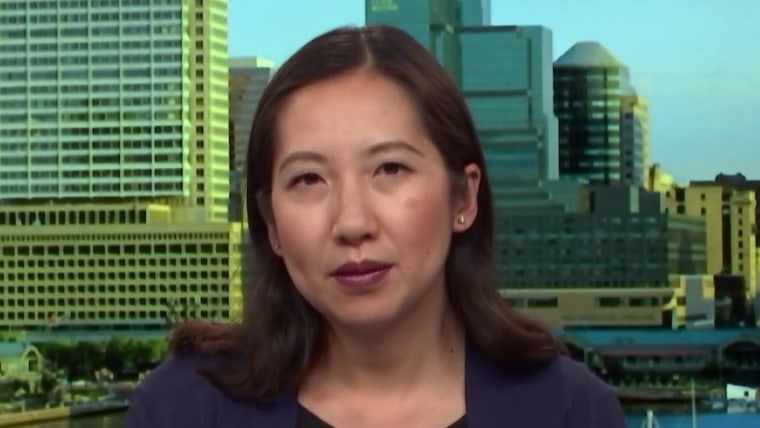A California patient who appears to be America's first case of a coronavirus transmission of unknown origin has prompted two major questions: How was she exposed to the virus, and who else might have it?
California public health officials on Thursday said they are trying to find those answers through contact tracing, a process that entails tracking down anyone in recent weeks who might have had contact with the patient, a woman whose identity they are not revealing.
Dr. Sonia Angell, director of the state's Department of Public Health, said at a news conference that since Wednesday — when the test came back positive for the coronavirus — local, state and federal health officials have been "contacting any individuals who might have been exposed, and they're isolating them."
Full coverage of the coronavirus outbreak
"This is a fluid situation at this time, and I want to emphasize that the risk to the general public is low," she said. She did not provide details on how many individuals were being tracked.
"This is a fluid situation at this time and I want to emphasize that the risk to the general public is low."
This is not the first instance of the coronavirus in the U.S., or even in California, but it is the first time a patient in this country has no clear connection to another sick person.
Experts say that in this case, contact tracing is the right approach to stave off "community spread," which is when a virus starts circulating within a local community and the source of infection is unclear.
But contact tracing is only feasible in certain situations, the experts added, highlighting the challenges health officials face in this case, as well as any future ones that don't appear to have a connection to China, where the outbreak started, or to other patients health officials were aware of.
Let our news meet your inbox. The news and stories that matters, delivered weekday mornings.
"If we see a case and there's no relation to a known case of coronavirus or a traveler, then there's an invisible line of transmission," said Dr. Tom Inglesby, director of the Center for Health Security at the Johns Hopkins Bloomberg School of Public Health. "It's been transmitted within the community. We don't know where it came from, there's at least one additional case we don't know about, and we don't know how many others there are."
Contact tracing involves interviewing family members, co-workers or anyone else who had "close and prolonged contact" with the patient, which typically means being within six feet of them for an extended period of time, Inglesby said.
"Depending on that person's life, that could be a small number or a large number. That work is pretty intensive and requires a lot of public health resources," he said. "So if there's only one case, that's obviously feasible. It gets difficult to scale on a large level. It's feasible and important to do at this point, but isn't necessarily the strategy that will hold in the long run."
"That work is pretty intensive and requires a lot of public health resources."
Even in the California patient's case, there may be hurdles. According to the UC Davis Medical Center, where the patient is being treated, she had been transferred from another hospital in the state and arrived intubated with a ventilator. While that assists with breathing, it can often make it difficult or impossible for a patient to communicate, especially if they have been sedated, said Dr. Frank Esper, a pediatric infectious disease specialist at Cleveland Clinic Children's Hospital whose research focuses on viral respiratory infections and newly recognized infectious diseases. In those situations, health officials typically go to their family members.
"Who did they live with, who were their neighbors? There's a lot you can get from an individual's social media posts," Esper said. "It becomes a very detailed history of what has your life been like over the last X number of days?"
People in close contact with the patient will be asked if they have had a cough, fever or difficulty breathing, symptoms that Esper said are also associated with the flu and other respiratory infections commonly seen this time of year. Regardless, the health department will likely screen those with concerning symptoms and advise some to self-quarantine in their houses while they wait for the test results.
Even if a test comes back negative, Esper added, health departments may re-screen contacts of the patient in the future.
The risk to the general public remains fairly low with the new coronavirus, with the majority of people expected to have mild symptoms, and U.S. hospitals have been preparing for weeks to accept those patients who experience more severe symptoms as the number of cases around the world has grown to more than 81,000.
But there have been hiccups.
At UC Davis, when the patient came in on Feb. 19, staff suspected the woman might have the coronavirus and took precautions to protect employees and other patients, the medical center said. But the Centers for Disease Control and Prevention initially declined to test the patient for COVID-19, the illness caused by the coronavirus, because the patient "did not fit the existing CDC criteria for COVID-19," a note to staff at UC Davis Medical Center said.
The CDC did not immediately return an inquiry from NBC News about why they waited until this week to test the patient. The woman is a resident of Solano County, California, and had no known exposure to the virus through travel or close contact with a known infected individual, according to the California Department of Public Health.
Until this week, testing for the coronavirus in the U.S. has been riddled with problems: Earlier this month, the CDC revealed that the test kits it sent out to labs across the country were flawed. Only the CDC headquarters in Atlanta and about a dozen other places in the country had the capacity to test for it.
On Thursday, Health and Human Services Secretary Alex Azar told a congressional hearing that the diagnostic problems had been resolved, and that the FDA had authorized 40 labs to use a modified test immediately and all 93 labs across the country to start using it by next week.
"I'm very pleased that the CDC is moving expeditiously on that, and it made firm commitments to the state of California that will significantly and exponentially expand our capacity to expand those testing protocols," Newsom said Thursday at a news conference.
Michael Osterholm, director of the Center for Infectious Disease Research and Policy at the University of Minnesota, called it "really unfortunate" that the UC Davis patient hadn't been tested earlier, and said that the ability to rapidly and accurately test for the coronavirus was going to be critical in the future.
"As cases continue to pile up, contact tracing just becomes not doable," he said.
Follow NBC HEALTH on Twitter & Facebook.
"case" - Google News
February 28, 2020 at 04:28AM
https://ift.tt/2Vug8OQ
After mystery coronavirus case in California, health officials go into detective mode - NBC News
"case" - Google News
https://ift.tt/37dicO5
Shoes Man Tutorial
Pos News Update
Meme Update
Korean Entertainment News
Japan News Update
Bagikan Berita Ini
















0 Response to "After mystery coronavirus case in California, health officials go into detective mode - NBC News"
Post a Comment